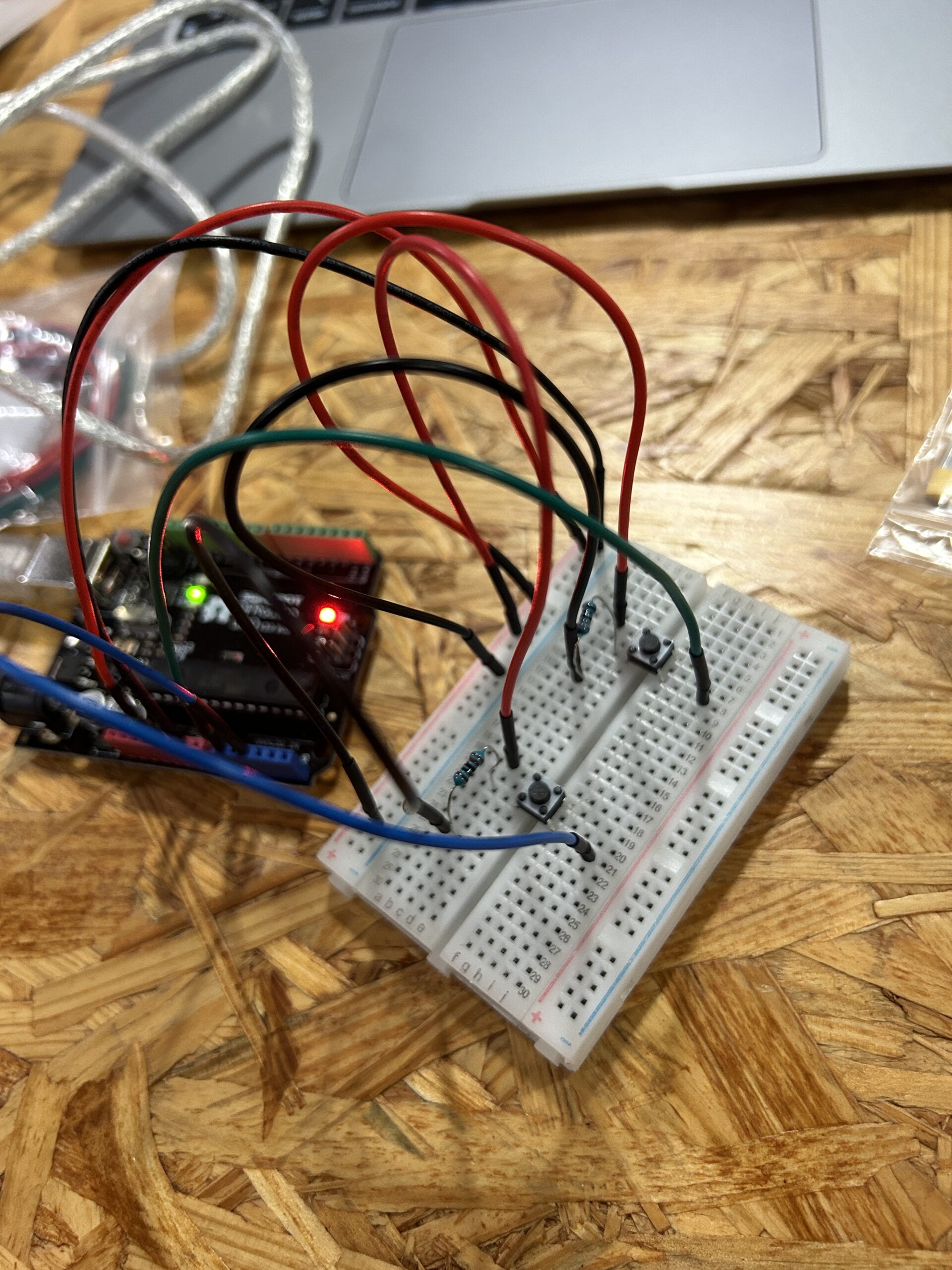Recitation 10: Image & Video
This is a prototype for my final project. We are using buttons to control the animations on processing. I started with one button to play the “do” note, so I replicated the circuit to allow the next button to control the “re” note.

After the circuit was done, I played the code, but only one button seemed to work. I tried to fix it by switching the buttons but that wasn’t the problem. Then, I switched it from the A2 plug in to A5 plug in. From this, I discovered that the A2 plug in on my Arduino board is broken.
This is a video of the final product. One button plays “do” and the other plays “re.” These sounds also produce random colored firework explosions on the processing screen.
Codes:
Processing
import processing.serial.*; import osteele.processing.SerialRecord.*; import processing.sound.*; Serial serialPort; SerialRecord serialRecord; SoundFile sound1; SoundFile sound2; float pre1; float pre2; int x; int y; int radius=100; boolean playSound1=true; boolean playSound2=true; int value1 = 0; //serialRecord.values[1]; int value2 = 0; //serialRecord.values[2]; class Fire { float a; float b; float va; float vb; color col; float lifetime = 100; Fire(float a, float b, float va, float vb, color col) { this.a = a; this.b = b; this.va = va; this.vb = vb; this.col = col; } void draw() { if (lifetime-50>0) { noStroke(); fill(col, lifetime-50); ellipse(a, b, 15, 15); lifetime -= 0.1; } } void update() { vb += G; a += va; b += vb; } } ArrayList<Fire> fireworks = new ArrayList(); final float G = 0.04; void setup() { //background(0); size(800, 800); String serialPortName = SerialUtils.findArduinoPort(); serialPort = new Serial(this, serialPortName, 9600); serialRecord = new SerialRecord(this, serialPort, 3); sound1 = new SoundFile(this, "do.aiff"); sound2 = new SoundFile(this, "re.aiff"); value1 = serialRecord.values[1]; value2 = serialRecord.values[2]; } void draw() { serialRecord.read(); ellipse(x, y, 150, 150); drawFireworks(); drawDo(); drawRe(); } void drawFireworks() { noStroke(); background(0); for (int i = 0; i < fireworks.size(); i++) { fireworks.get(i).update(); fireworks.get(i).draw(); } if (value1==1023||value2==1023) { fireworks.clear(); color c = color(random(50, 255), random(50, 255), random(50, 255)); int numFires = (int)random(4, 1000); //float x = random(0, 500); //float y = random(0, 500); for (int i=0; i<numFires; i++) { float r = random(0, TWO_PI); float R = random(0, 2); fireworks.add(new Fire(width/2,height/2 , R*sin(r), R*cos(r), c)); } } } void drawDo() { value1 = serialRecord.values[1]; if (value1 == 1023) { x=x+1; if (playSound1 == true) { sound1.play(); playSound1 = false; } fill(200, 0, 100); } else { playSound1= true; fill(255); } } void drawRe() { value2 = serialRecord.values[2]; if (value2 == 1023) { y=y+1; if (playSound2 == true) { sound2.play(); playSound2 = false; } fill(200, 0, 100); } else { playSound2= true; fill(255); } }
Arduino
#include "SerialRecord.h" // Change this number to send a different number of values SerialRecord writer(3); void setup() { Serial.begin(9600); } void loop() { int sensorValue1 = analogRead(A0); int sensorValue2 = analogRead(A5); writer[0] = millis() % 1024; writer[1] = sensorValue1; writer[2] = sensorValue2; writer.send(); // This delay slows down the loop, so that it runs less frequently. This // prevents it from sending data faster than a Processing sketch that runs at // 60 frames per second will process it. It also makes it easier to debug the // sketch, because values are received at a slower rate. delay(100); }